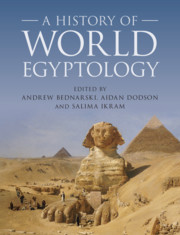Book contents
- A History of World Egyptology
- A History of World Egyptology
- Copyright page
- Dedication
- Contents
- Figures
- Notes on Contributors
- Preface
- A Note on Academic Titles
- Abbreviations and Conventions Used in Text
- Maps
- Introduction
- Chapter 1 The Prehistory of Egyptology
- Chapter 2 Egypt
- Chapter 3 France
- Chapter 4 The British Isles
- Chapter 5 The Netherlands
- Chapter 6 Belgium
- Chapter 7 The Nordic Countries
- Chapter 8 Prussia and Germany
- Chapter 9 The Empire of Austria-Hungary and the Republic of Austria
- Chapter 10 Switzerland
- Chapter 11 Hungary
- Chapter 12 Czechoslovakia
- Chapter 13 Poland
- Chapter 14 Russia
- Chapter 15 Italy
- Chapter 16 Spain
- Chapter 17 United States of America
- Chapter 18 Canada
- Chapter 19 Japan
- Chapter 20 Australasia
- Chapter 21 Ancient Egypt in the Cinema
- Chapter 22 Past and Future
- Bibliography
- Index
Chapter 15 - Italy
Published online by Cambridge University Press: 01 June 2021
- A History of World Egyptology
- A History of World Egyptology
- Copyright page
- Dedication
- Contents
- Figures
- Notes on Contributors
- Preface
- A Note on Academic Titles
- Abbreviations and Conventions Used in Text
- Maps
- Introduction
- Chapter 1 The Prehistory of Egyptology
- Chapter 2 Egypt
- Chapter 3 France
- Chapter 4 The British Isles
- Chapter 5 The Netherlands
- Chapter 6 Belgium
- Chapter 7 The Nordic Countries
- Chapter 8 Prussia and Germany
- Chapter 9 The Empire of Austria-Hungary and the Republic of Austria
- Chapter 10 Switzerland
- Chapter 11 Hungary
- Chapter 12 Czechoslovakia
- Chapter 13 Poland
- Chapter 14 Russia
- Chapter 15 Italy
- Chapter 16 Spain
- Chapter 17 United States of America
- Chapter 18 Canada
- Chapter 19 Japan
- Chapter 20 Australasia
- Chapter 21 Ancient Egypt in the Cinema
- Chapter 22 Past and Future
- Bibliography
- Index
Summary
In January 1831, the Parisian printer Firmin Didot published a Manifesto announcing the imminent publication of the Egyptian and Nubian monuments by Jean-François Champollion and Ippolito Rosellini, based on the notes and images made during the 1828–29 Franco-Tuscan expedition (see p. 22). It contained a description of the work, equally divided between the French and the Italians, to be organised in three parts, to include albums of plates and volumes of texts in French and Italian, and to be issued in a series of fascicles. The death of Champollion in 1832, and subsequent conflicts between his brother Champollion-Figeac and Rosellini, stymied the joint project. Rosellini thus published his Monumenti dell’Egitto e della Nubia alone, in the face of many financial and interpersonal problems, between 1832 and his untimely death in 1843. The ninth and last volume of text and the third and last volume of plates, already prepared by the author, were posthumously published in 1844. This monumental work, presenting an extraordinary quantity of textual, archaeological and visual material, has been fundamental for the development of Egyptology in the Italian peninsula. Almost all the important Italian libraries subscribed to its fascicles, as attested by letters that Rosellini himself wrote to librarians and scholars all over Italy, asking them to sign the subscription Manifesto or informing them about the plans for the publication.
- Type
- Chapter
- Information
- A History of World Egyptology , pp. 369 - 396Publisher: Cambridge University PressPrint publication year: 2021
- 27
- Cited by



